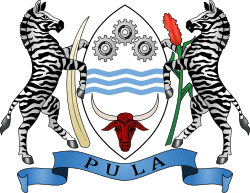Constitution of Botswana
 |
|---|
| This article is part of a series on the politics and government of Botswana |
| Constitution |
|
The present Constitution of Botswana commenced on September 30, 1966.[1]
Background
Before colonial rule was established in Botswana, a traditional constitution - a body of laws known as molao - was used by tribal chiefs, or diKgosi, of the Botswana people[2]. During the early years of the Bechuanaland Protectorate, some non-Botswana also came to be ruled by these laws[3]. Protectorate administrators kept elements, though not all, of this traditional constitution; much of it has lapsed today.[4]
In 1959, a Constitutional Committee of the Joint Advisory Council drew up the Protectorate's first formal constitution, which came into operation in 1960.[5] In 1963 consultations began for a second constitution which would confer self-government.[5] The 1965 general election was held under this constitution, which was modelled on the Westminster system of parliamentary democracy: there was a unicameral legislature; a prime minister and cabinet of five ministers responsible to the legislature; and a purely consultative Ntlo ya Dikgosi.[5]
When Botswana achieved full independence on 30 September 1966, the prime minister was replaced by a president elected by the legislature (renamed the National Assembly, and given executive powers.[6]
A series of later amendments to the Constitution have increased the number of elected members of the National Assembly, and the size of the Ntlo ya Dikgosi. Other constitutional changes were made in 1994 and 1997.[7]
Structure
The constitution is divided into 9 chapters, each detailing certain areas such as individual rights and the delegation of executive powers.[8]
- The Republic
- Protection of Fundamental Rights and Freedoms of the Individual
- Citizenship
- The Executive
- Parliament
- The Judicature
- The Public Service
- Finance
- Miscellaneous
The Republic
This section declares Botswana an independent nation as well as defines the public seal.
Protection of Fundamental Rights and Freedoms of the Individual
This section defines the rights of the citizens. It begins by stating that everyone is guaranteed rights regardless of race, creed, or sex. The rights are as follows: "(a) life, liberty, security of the person and the protection of the law; (b) freedom of conscience, of expression and of assembly and association; and (c) protection for the privacy of his or her home and other property and from deprivation of property without compensation, the provisions of this Chapter shall have effect for the purpose of affording protection to those rights and freedoms subject to such limitations of that protection as are contained in those provisions, being limitations designed to ensure that the enjoyment of the said rights and freedoms by any individual does not prejudice the rights and freedoms of others or the public interest."
Citizenship
This section was repealed from the constitution.
The Executive
This section defines the executive branch including the President, Vice President, and Cabinet.
The President
The President is the chief executive of the state. The President is elected president by members of the National Assembly. These members state on the ballot who they would support for President if elected, and after election to the National Assembly vote for whomever they indicated they would elect as President. The President has the following requirements: (a) is a citizen of Botswana by birth or descent; (b) has attained the age of 30 years; and (c) is qualified to be elected as a Member of the National Assembly. The Presidents term is limited up to 10 years, or however long the President holds office in the National Assembly.
The executive power of Botswana resides solely in the President. The President is also the commander of the armed forces. The president also has the power to pardon a person convicted of a crime
The Vice President
The Vice President is chosen by the President from among the members of the National Assembly. The Vice President takes over for the President when the President is unable to fulfill his duties either because of illness, death, or other reasons.
The Vice President is second-in-command to the President and carries out the missions of the President.
The Cabinet
This Cabinet is composed of the President, the Vice President and no more than six ministers who are appointed by the President from the National Assembly. The Ministers in the Cabinet are responsible for advising the President with respect to policy of the government.
References
- ↑ (http://www.hydrant.co.uk), Site designed and built by Hydrant. "Botswana : Constitution and politics | The Commonwealth". thecommonwealth.org. Retrieved 2018-10-04.
- ↑ Mafela, Lily (2007-12-15). "Batswana Women and Law". Cahiers d'études africaines. 47 (187–188): 523–566. doi:10.4000/etudesafricaines.7962. ISSN 0008-0055
- ↑ Griffiths, J. E. S. (1970). [www.jstor.org/stable/40980765 "A Note on Local Government in Botswana"] Check
|url=value (help). Botswana Notes and Records. 2: 64–70 – via JSTOR. - ↑ WOOLRYCH, Austin (1990). "The Cromwellian Protectorate: A Military Dictatorship?". History. 75: 207–231 – via JSTOR.
- 1 2 3 Barry,, Morton,. Historical dictionary of Botswana. Ramsay, Jeff,, Based on (work): Morton, Fred, 1939- (Fifth edition ed.). Lanham, Maryland. ISBN 9781538111321. OCLC 1037884220
- ↑ Sebudubudu, David (December 2011). "Wealth Sharing for Conflict Prevention and Economic Growth: Botswana Case Study of Natural Resource Utilization For Peace and Development". University of Botswana.
- ↑ Poteete, Amy. (2018). Renegotiation of Executive Powers and Executive-Legislative Relations in Botswana.
- ↑ "Botswana 1966 (rev. 2002)". Constitute. Retrieved 9 April 2015.